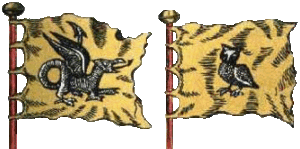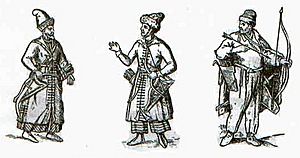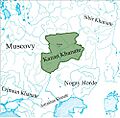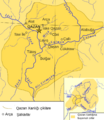Khanate of Kazan facts for kids
Quick facts for kids
Khanate of Kazan
|
|||||||||
|---|---|---|---|---|---|---|---|---|---|
| 1438–1552 | |||||||||
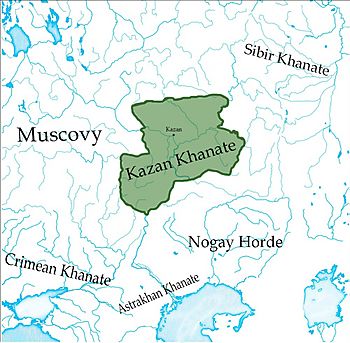
The Khanate of Kazan (green), c. 1500.
|
|||||||||
| Status |
Independent
(1438-1521,1551-1552)Vassal of the Crimean Khanate
(1521-1551) |
||||||||
| Capital | Kazan | ||||||||
| Common languages | Turkic (Tatar, Chuvash), Mari | ||||||||
| Religion | Islam, Shamanism | ||||||||
| Government | Khanate | ||||||||
| Kazan Khan | |||||||||
|
• 1438-1445
|
Olug Moxammat (first) | ||||||||
|
• March-October 1552
|
Yadegar Moxammat (last) | ||||||||
| History | |||||||||
|
• Established
|
1438 | ||||||||
|
• Annexed to Muscovy
|
1552 | ||||||||
|
|||||||||
| Today part of | Russia | ||||||||
The Khanate of Kazan (Tatar: Казан ханлыгы; Russian: Казанское ханство, romanized: Kazanskoye khanstvo) was a medieval state in Eastern Europe. It was ruled by a Khan, a type of king. This state existed from 1438 to 1552. It was located in the area of the old Volga Bulgaria.
The Khanate covered parts of what is now Russia. This includes modern-day Tatarstan, Mari El, Chuvashia, and Mordovia. It also included parts of Udmurtia and Bashkortostan. The capital city was Kazan. The Khanate of Kazan was one of the new states formed after the Golden Horde broke apart. It ended when the Tsardom of Russia conquered it.
Contents
Exploring the Land and People
The Khanate of Kazan was built on lands once part of Volga Bulgaria. These lands were home to Muslim people called Bulgars. The main rivers were the Volga, Kama, and Vyatka. These rivers were important for trade.
Most people living in the Khanate were Kazan Tatars. Many identified themselves as Muslims or "people of Kazan." Islam was the official religion of the state.
Diverse Groups of People
The local nobles were Bulgars. However, the Khan's court and guards were made up of steppe Tatars. These included Kipchaks and later Nogais. They lived in Kazan. The local Turkic tribes were also called Tatars. This name was given by the steppe nobles and later by the Russians.
Many different groups lived under the Khan's rule. These included the Chuvash, Mari, Mordva, Mishar Tatars, Udmurt, and Bashkir. Some Perm and Komi tribes were also part of the Khanate.
Languages Spoken
People in the Kazan Khanate spoke at least five languages. The most important was the Tatar language. This included the Middle dialect of Kazan Tatars and the Western dialect of Mishars. The written form, called Old Tatar language, was used by the government.
The Chuvash language came from the Bolgar language. It was spoken by the pagan Chuvash people. The Bolgar language also greatly influenced the Tatar language. Other languages spoken were likely Mari, Mordvin languages, and Bashkir language.
A Look at History
The area of Volga Bulgaria became more independent around the 1400s. This happened as the Golden Horde empire weakened. The region was self-governed. Its rulers came from the Bolgar dynasty.
The founder of the Khanate was Ulugh Muhammad. He became Khan in 1437 or 1438. He took control with help from local nobles. His son, Maxmud, likely finished this transfer of power in 1445.
Early Years of the Khanate
Throughout its history, the Khanate often faced internal conflicts. Rulers changed many times. There were 15 different Khans, and some ruled more than once. The Khan was often chosen by the nobles and even by the citizens.
During the rule of Ulugh Muhammad and his son Maxmud, Kazan forces attacked Muscovy several times. Vasily II of Moscow was defeated in a battle. He had to pay money to the Kazan Khan.
In 1487, Grand Duke Ivan III of Moscow took over Kazan. He put a leader, Möxämmädämin, on the Kazan throne who supported Moscow. After this, the Kazan Khanate became a state protected by Moscow. Russian traders could now trade freely there.
In 1521, Kazan became free from Moscow's control. It made a treaty with the Astrakhan Khanate, the Crimean Khanate, and the Nogay Horde. Their combined forces then attacked Muscovy.
The Final Years
The growing power of Crimea made some Kazan nobles unhappy. These nobles started a revolt in 1545. As a result, Safa Giray was removed from power. A supporter of Moscow, Şahğäli, became Khan. Moscow tried several times to control Kazan, but they failed.
With help from the Nogays, Safa Giray returned to power. He punished many nobles. In 1549, he died. His 3-year-old son, Ütämeşgäräy, became Khan. His mother, Söyembikä, ruled for him.
Relations with Russia became worse. In 1551, some unhappy nobles invited Şahğäli, a supporter of Tsar Ivan the Terrible, to rule again. The lands east of the Volga were given to Russia. Ütämeşgäräy and his mother were sent to a Moscow prison. Şahğäli ruled Kazan until February 1552. Then, those against Moscow exiled Şahğäli. They invited Yadegar Mokhammad, a prince from the Astrakhan Khanate, to help them.
The Downfall of Kazan
In August 1552, the forces of Ivan the Terrible attacked Kazan. They started their attack from the Russian castle of Sviyazhsk. The Russians defeated the Tatar troops outside the city. They burned nearby towns and castles.
On October 3, after two months of fighting, the Russians entered the city. They broke through the walls of the citadel. Many defenders tried to escape, but most were killed. Yadegar Moxammad was captured. Many people in the city lost their lives.
After Kazan fell, other areas like Udmurtia and Bashkortostan joined Russia peacefully. The Khanate's government was completely removed. Nobles who supported Moscow or stayed neutral kept their lands. Others were executed. Tatars were moved away from rivers, roads, and Kazan. Russians and pro-Russian Tatars settled the empty lands. Orthodox bishops, like Germogen, made many Tatars change their religion.
Continued Resistance
Some people continued to fight against Russian rule until 1556. Rebel groups formed in different places. However, the Nogays often attacked the farming population. This weakened the rebels. After a harsh crackdown, the rebel leaders were executed.
The wars caused the population of the former Khanate to shrink. The new Russian government tried to make Tatars and other groups more like Russians. They also tried to make them Christian. The name Tsardom of Kazan was used until 1708. That's when the Kazan Governorate was created.
Economy and Trade
People in the cities of the Khanate made many things. They produced clay pots, wood and metal crafts, leather goods, armor, and jewelry. Major cities included Qazan, Arça, and Cükätaw.
The people in the cities also traded with those in Central Asia, the Caucasus, and Russia. By the 16th century, Russia became Kazan's main trading partner. The Khanate shared an economic system with Moscow. The main markets were the Taşayaq Bazaar in Kazan and the Markiz Isle fair on the Volga River.
Society and Government
The Khan was the ruler of the state. He made decisions with advice from a special council called the Diwan. The nobles included ranks like bäk (beg), ämir (emir), and morza. Military leaders were called uğlan (ulan), bahadir, and içki.
Muslim religious leaders were also very important. They were divided into säyet (seid), şäyex (sheikh), qazí (qazi), and imams. The ulema, or religious scholars, helped with legal matters. They also ran madrassas (schools) and maktabs (libraries).
Most people were qara xalıq (black people). These were free Muslims who lived on state land. Feudal lands were mostly worked by çura (serfs). Prisoners of war were sometimes sent to other places like Turkey or Central Asia. Sometimes they were sold as slaves (qol) within the Khanate. Later, some became çura. Both Muslim and non-Muslim people in the Khanate had to pay a tax called the yasaq.
Administration and Military
The Khanate was divided into five main regions called daruğa. These regions replaced the older "duchies." Sometimes, local lords tried to become independent from Kazan. However, these attempts were quickly stopped.
The Khanate's army was made up of soldiers from these regions and subject lands. It also included the Khan's guards and troops from the nobles. The number of soldiers changed, from 20,000 to 60,000. Troops from the Nogay, the Crimea, and Russia also sometimes served the Kazan Khans. Guns (arquebuses) were used to defend the walls of Kazan.
Culture and Arts
The culture of the Kazan Khanate mostly came from Volga Bulgaria. Elements of the Golden Horde culture were also seen among the nobles.
Many people in the cities could read and write. Large libraries were found in mosques and madrassahs. Kazan became a center for learning and religious studies.
While Islamic influence was strong, other types of literature also grew. Famous poets who wrote in the Old Tatar language included Ömmi Kamal, Möxämmädämin, Ğärifbäk, and Qolşärif. Möxämmädyar brought new ideas to Kazan poetry, and his poems were very popular.
The city of Bolghar remained a sacred place. However, Kazan became the main economic and political center in the 1430s. The buildings of the Khanate were known for their white-stone architecture and beautiful wood carvings.
Images for kids
See also
 In Spanish: Kanato de Kazán para niños
In Spanish: Kanato de Kazán para niños



